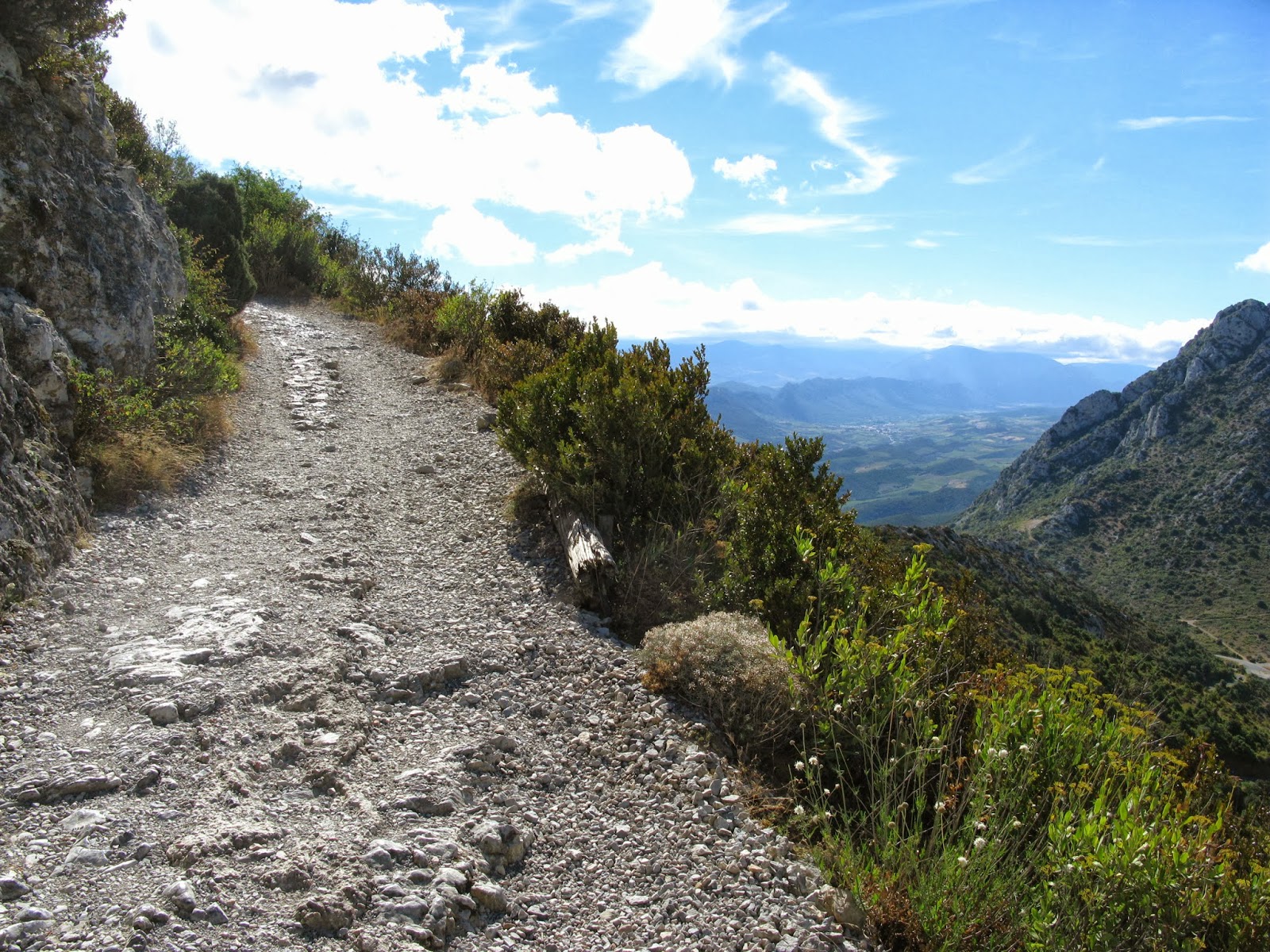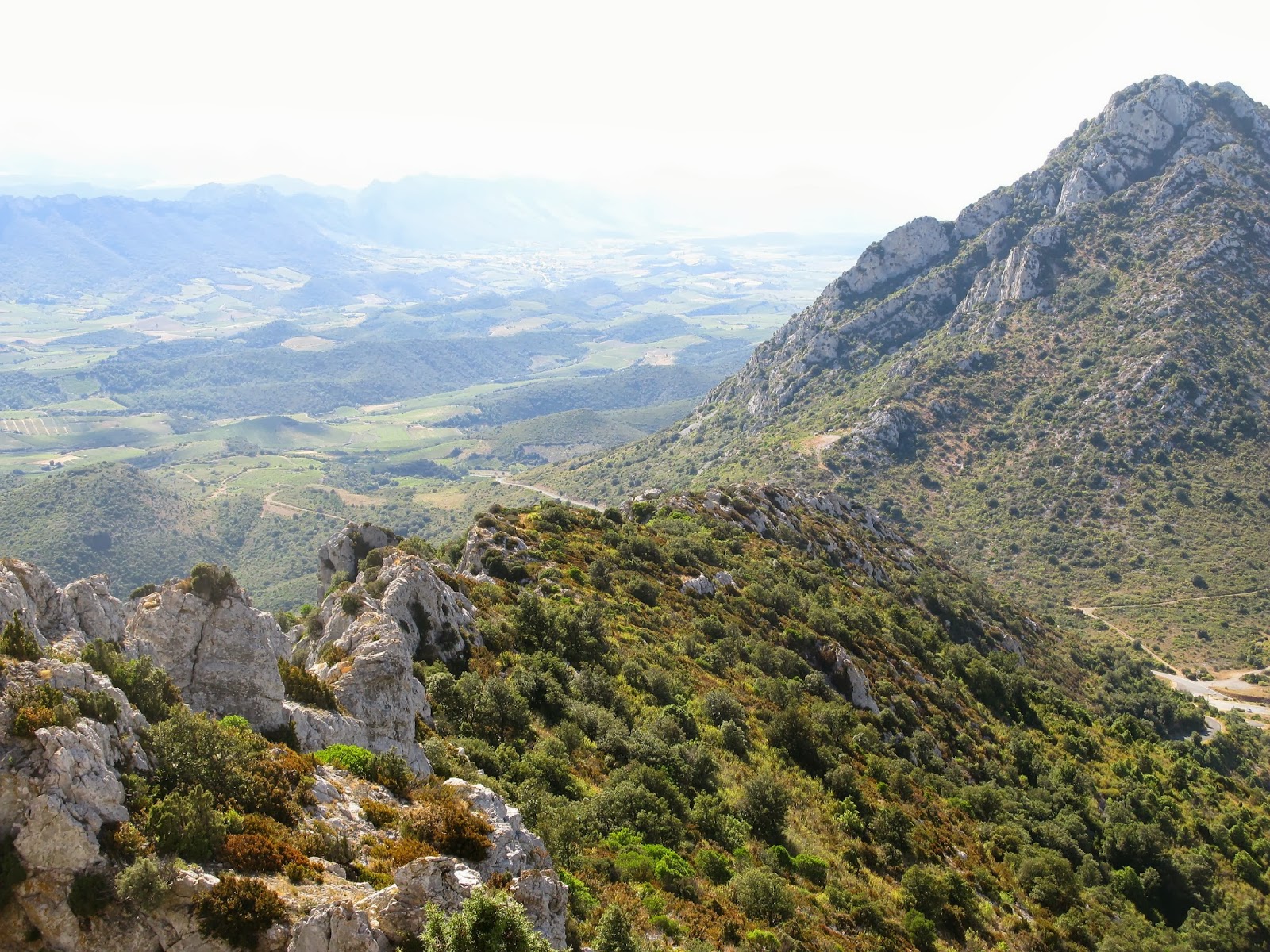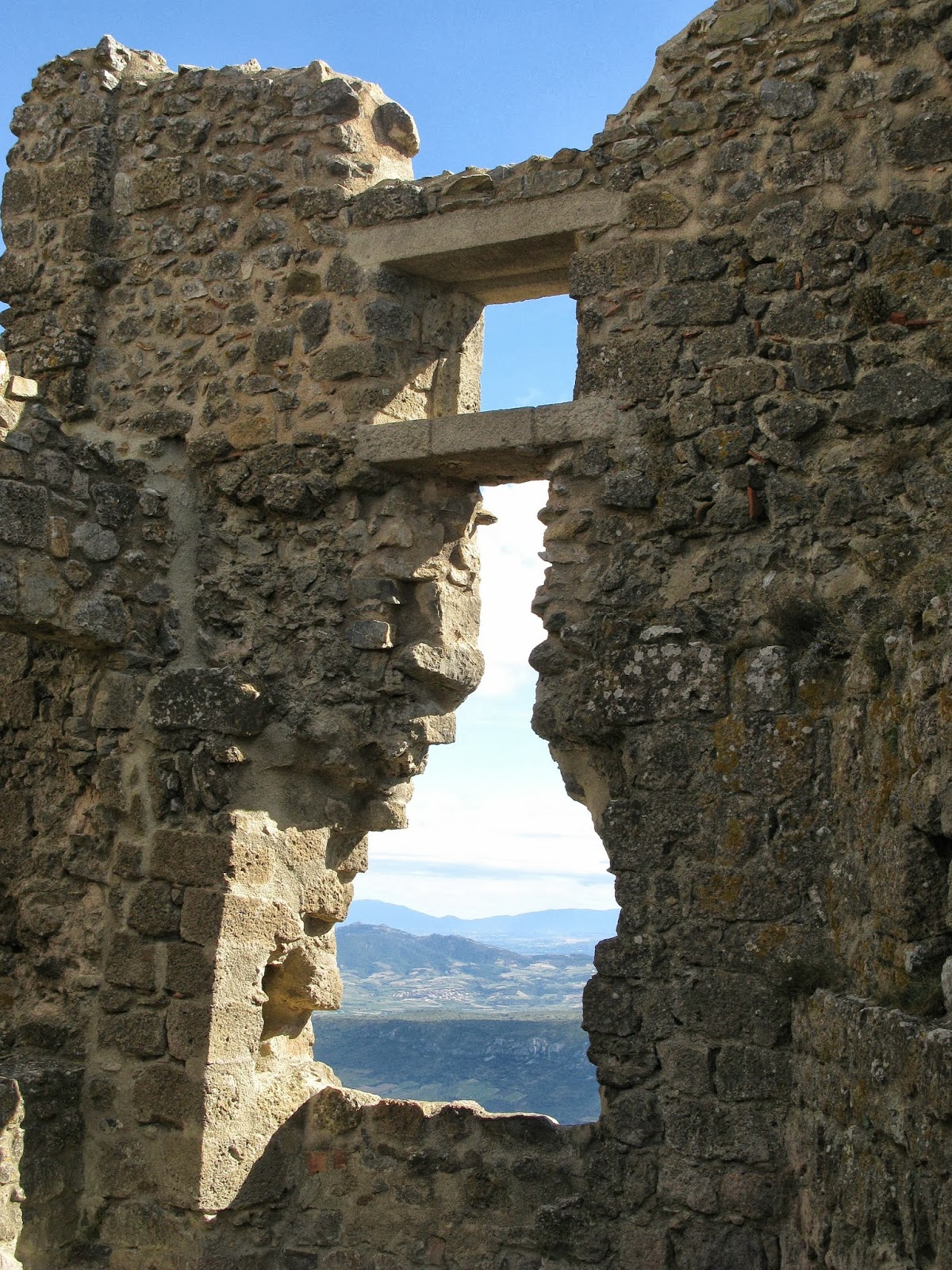Lagrasse & Quéribus
One does not drive TO the Cathar Country since we are IN Cathar Country. However, we can drive to the various Châteaux and Fortresses that played a significant role during the Cathar period of history.
The area of Corbières, within the department of Languedoc-Roussillon, is still one of the wildest parts of France with few roads, let alone villages. It is best known for its wine (being the largest wine-producing area of France, producing half of France's table wine), and the great craggy hulks of the Cathar castles. Much of the land is untamed garrigue (scrubland), fragrant with honeysuckle and broom; south-facing slopes have been cleared and planted with vines.
One cannot tour all of the Cathar Country in one outing, but we ventured forth on a hot and sunny day, enjoying the drive. It's a bit like getting on an exhilarating ride at the fair with the narrow winding roads, the hairpin turns, the vertigo drops.
 |
| We can make out the windy road that we've just traversed. |
What wild country and so different from the scenery we drove through ten minutes ago!
We started off with a visit to Lagrasse, a medieval village situated in the heart of a very diverse environment. Surrounded by jagged cliffs and limestone plateaus, vineyards, olive groves, and more recently, oak groves for the production of truffles, the natural beauty of the area has been exceptionally well preserved.
 |
| Old cart bridge leading into Lagrasse. |
 |
| Copycat auto bridge leading into Lagrasse. |
 |
| Typical narrow street, too narrow for cars. |
 |
| One of the few streets in the centre capable of accommodating cars. |
 |
| Today's homes, still looking very medieval. |
 |
| Close up of old stone bridge. |
 |
| A home whose owner takes pride in making it look good. |
 |
| "Les trois graces" (in Lagrasse). Great play on words! |
 |
| Ancient doors. |
 |
| Note old covered roof. |
 |
| Winged devil/angel as faucet. |
 |
| Notice proximity of buildings. |
 |
| Street leading to church at end. |
 |
| Ancient part of Abbey as well as section still in use. |
The Historic Monument Saint Marie d'Orbieu was once a Benedictine Abbey and is known for its elegance and refinement. According to legend, the Abbey was founded by the Emperor Charlemagne and enjoyed a period of great prosperity. When Charlemagne found the monks well protected in the midst of such an unforgiving environment, he changed their name from "Le Maigre" (the thin) to "La Grasse" (the fat).
This impressive edifice traversed centuries of history, flourishing during periods of artistic and political progress and surviving years of upheaval until the Revolution, when it was confiscated from the clergy and sold as state property.
This is where the water came into the baking room where fragrant breads came out of huge ovens. Pretty basic plumbing.
 |
| Original food storage section. |
 |
| Abbotts' central refuge for prayer - the altar. |
 |
| Stairs leading to 2nd floor dormitory. |
 |
| Dormitory in current state of disrepair. |
 |
| Note ship-like rafters in dormitory. |
 |
| By all appearance a sandy floor, but actually tile work. |
 |
| Doorway from dormitory to outside walkway on 2nd floor. |
 |
There is no furniture to be found in this Abbey. Traces of centuries of history can be found in the architecture of the Abbey. It was during the 13th century, known for the Albigesian Crusade, that the majority of this architectural jewel was constructed.
.
 |
| Road and wall surrounding Abbey. |
 |
| Today's monks living in the part of the Abbey not open to the public. |
***
One cannot explore and journey too far without sustenance.
We had the best quiche Lorraine with a salad and wine...
... followed by chocolate pie, pound cake and Chantilly (whipped cream). That should keep us going for the afternoon.
 |
| Vineyards... |
 |
| ...and more vineyards. |
 |
| Incredible vistas. |
 |
| Our little Peugeot gets us there. |
 |
| Wild country. |
 |
| Yes, land where religious wars were fought. |
 |
| These horses seem to have stopped their grazing to pose for this photo! |
 |
| Hot, windy, dry.
|
 |
| Karl had quite the hike to get to the very top. |
Dominating the meridional Corbières, Quéribus was only mentioned in texts in 1020. It was one of the major châteaux of the northern boundaries of the kingdom of Aragon from 1162.
Following the fall of Montségur in 1244, Quéribus sheltered the last rebels to the new order imposed by the King of France and the Catholic Church. This situation was not tolerated by the Crown of France who forced Chabert de Barbaira to surrender the citadel in 1255.
As a royal fortress, refurbished Quéribus surveyed the border between the kingdoms of France and Aragon. Quéribus remains the evidence of the dramatic events that have marked the history of the region.
Since I didn't do the hike, Karl took loads of photos to provide me with a detailed photo journal of what he saw. It was almost like being there!
 |
| Footpath leading to Quéribus. |
 |
| View from halfway up. |
 |
| Closer view of craggy surroundings. |
 |
| Rough road leading to gate. |
 |
| View from top looking south towards Spain. |
The access ramp, sometimes cut out of the rock, is under the control of the defenders. Several systems of defence are visible: arches and gatehouses. The vulnerable spots are equipped with a means of surveillance: covered pathways, blockhouse. Between fifteen and twenty men sufficed to defend the castle.
 |
| Wind is extremely strong at this height. |
Three terraced ramparts extend the cliff. From the third rampart, overlooking the building, to the first rampart, the different types of openings and the structure of the walls show several methods of construction. The fine archer's slits, used by the crossbowmen to the wider lethal canon apertures for firearms, four centuries of evolution are represented.
 |
| Cathedral-like ceiling. |
 |
| Sturdy columns that have stood the test of time. |
 |
| Stairs to main tower. |
***
This is the town of Cucugnan at the base of Quéribus.
If your eyesight is good, you may spy the windmill in the upper left quadrant. It is "Omer's" windmill. It is mentioned in the archives in 1692 and belonged to Lord Cucugnan.
The windmill blades are orientated towards the wind due to a pivoting roof. They are covered with canvas, which the miller unfolded depending on the strength of the wind.
It proves the existence of mixed farming where wheat was of major importance until halfway through the XIX century. The local economy depended upon cereals and on the breeding of goats and sheep.
*****
Sidebar: Since this blog is a memory keeper for our travels, I will add some historical info that may not be of interest to all.
The adjective "cathar" is currently used to define several realities and as many "imaginary" events. During the mid XIIth century the term "cathar" was employed by the Catholic Church to describe the members of a community of "travelling apostles" which it condemned for the first time at Bonn and Cologne, in the Rhineland. Cathar communities soon appeared in various parts of Western Europe under different names (piphles, publicans, weavers, patarins, buggers, Albigensians). However, it was in the present French Midi and in the towns of north and central Italy that Catharism was most favourably accepted. In all these regions the "good men" or "good women", "good Christians" as they called themselves were organized in communities of men or women, in "houses" according to the model of the primitive church.
The Cathar communities were not unaware of the Christian spirituality dominating their era. On the contrary, they claimed, in opposition to the teachings of other contemporary religions, the return to Church dogma as taught during the early times of Christianity. They thus condemned the Roman Catholic Church, arguing that it did not respect the teachings of Christ.
The Roman Catholic Church, influenced by its constant need to systematize the Christian faith and the structure of a dogma enclosed within strict religious obedience, became alarmed by the spread of the Cathar belief.
From 1209 Pope Innocent III launched the first Holy war in Europe, the Albigensian Crusade. This campaign, which entailed twenty years of siege and ranged battle, diplomatic negotiation and guerilla warfare, would end in religious failure, but political success or defeat.
In 1233 Pope Gregory IX introduced a new penal legal system: The Inquisition. He entrusted this task mainly to the Dominican and Franciscan mendicant orders. The Inquisition, which had to be considered as a redoubtably efficient and professional institution, meticulously worked for almost a century to eradicate the slightest trace of the Cathar faith.
But at what a price...
Quéribus, the last citadel of southern Corbières, was conquered in 1255, adding an almost final chapter to all resistance to the new powers in place. The signature of the Treaty of Corbeil in 1259 fixed, until the Treaty of the Pyrénées under Louis XIV and the annexing of Roussillon by France, the boundaries of the two countries.
In order to defend their southern territory, the royal powers constructed or refurbished a line of fortresses each more formidable than the other, commanded by Carcassonne. Historical witnesses of a southern world subject to perpetual economic, social and cultural transformation, they still form today the principal elements of the memory of this land: The Cathar Country.
***



















































No comments:
Post a Comment